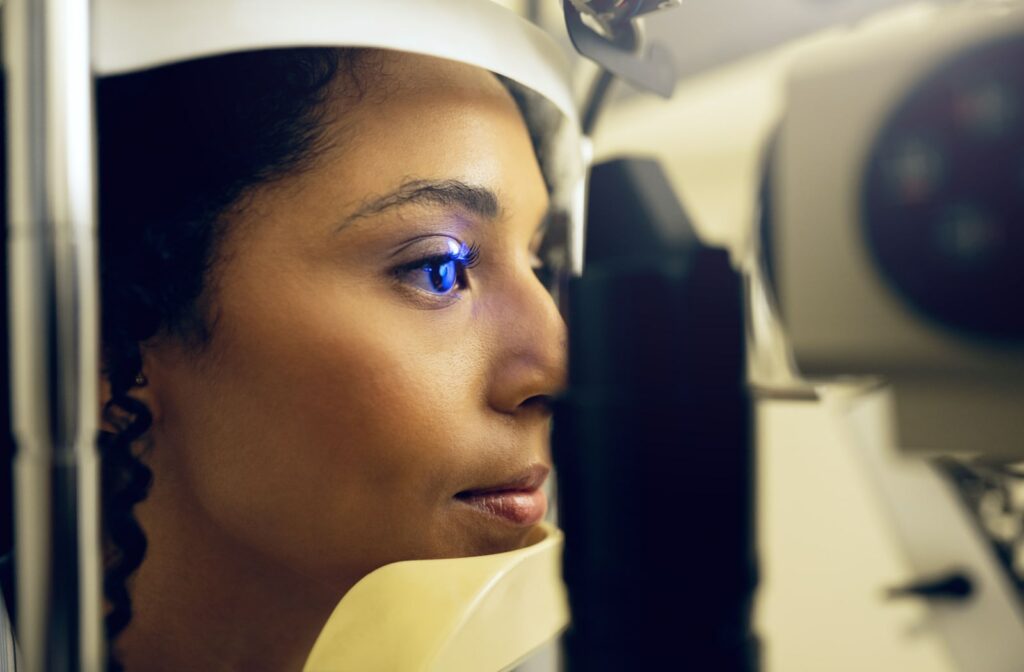A diabetic eye exam is a comprehensive eye examination specifically for those who have diabetes or are at risk of developing diabetes. These exams typically involve eye dilation so the eye doctor can assess the inner eye for abnormal blood vessel development. The eye doctor can use optical technology, such as fundus photography, optical coherence tomography, and a slit lamp biomicroscopy, to detect diabetes-related eye conditions.
Your eye doctor can determine whether you need a diabetic eye exam versus a standard comprehensive eye examination based on your eye health history and your answers about your medical history. For example, they may recommend a dilated exam even if you haven’t been diagnosed with diabetes if you are at high risk of developing the disease.
What Is a Diabetic Eye Exam?
A diabetic eye exam is a comprehensive eye exam conducted by an eye doctor to examine the impact of diabetes on your eyes. The doctor will typically use eye drops to widen your pupils (dilate them) to get a better view of the retina and other structures in the back of your eye. During the exam, your optometrist checks for any signs of vision loss or damage to the blood vessels in the retina.
How Does a Diabetic Eye Exam Differ from a Comprehensive Eye Exam?
A diabetic eye exam typically incorporates most of the testing that a “normal” comprehensive eye examination does. The primary difference is that a diabetic eye exam is usually done when there is a diabetes diagnosis or an individual is at risk of developing it. This leads to a greater focus on assessing retinal health and the blood vessels within the eye.
Who Needs a Diabetic Eye Exam?
Anyone who is diagnosed with diabetes should get a diabetic exam. If someone is at a high risk of developing diabetes or if they have pre-diabetes, their eye doctor may recommend diabetic eye exams to minimize the risk of diabetes-related eye complications, such as diabetic retinopathy, cataracts, or glaucoma.
How Often Do You Need a Diabetic Eye Exam?
It’s recommended that people with diabetes undergo a diabetic eye exam at least once a year. However, those with a history of diabetic-related eye conditions or those who have had diabetes for an extended period of time may need more frequent checkups.
You should ultimately follow your eye doctor’s recommendations because frequency can vary based on eye health, age, and vision needs.
One important thing to remember is if your vision changes between exams, you should go see your eye doctor as soon as possible.
Diabetes-Related Eye Complications
Several eye complications can arise from diabetes. In addition to their regular testing, the eye doctor typically focuses on a few particular eye diseases and conditions.
Diabetic Retinopathy
Diabetic retinopathy is a condition that affects people with diabetes. It occurs when fluctuating blood sugar levels cause damage to the blood vessels in the retina, the light-sensitive tissue at the back of the eye. This damage can lead to vision problems and vision loss if left untreated.
Treatment options may include laser therapy, medication, or surgery, depending on the severity of the condition.
Diabetic Macular Edema
Diabetic macular edema (DME) is a condition that can affect people with diabetes. It happens when fluid builds up in the macula, which is the central part of the retina responsible for sharp vision. This fluid accumulation can cause the macula to swell and lead to blurry or distorted vision.
If left untreated, DME can have a significant impact on a person’s ability to see clearly. Treatment options may include medications, laser therapy, or injections into the eye.
Cataracts
Although cataracts are often an age-related condition, they are also connected to diabetes, specifically high blood sugar levels. People with diabetes have a higher risk of developing cataracts because high blood sugar levels can cause changes in the lens of the eye, leading to cloudiness and the formation of cataracts.
Cataracts can make vision blurry, hazy, or cause sensitivity to light. Cataracts don’t immediately need treatment, but once they affect an individual’s daily life, cataract surgery is the only way to restore the impaired vision.
Glaucoma
Individuals with diabetes may have a 36% increased risk of developing open-angle glaucoma, which is frequently caused by increased pressure inside the eye. This pressure leads to optic nerve damage, affecting peripheral vision first.
Discuss Your Eye Health with Your Eye Doctor
Diabetes is a common but manageable disease. And how it relates to your eye health is no different. Ensuring you see your eye doctor for all recommended examinations can provide the best chance at preventing diabetes-related eye conditions or diseases.
Contact our team at Maple Ridge Eye Care to book your next exam if you’ve recently been diagnosed with diabetes or you’re having any trouble seeing clearly.

